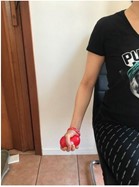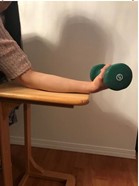Dialysis
Exercise for your new AV fistula
What is an arteriovenous (AV) fistula?
An AV fistula is made when an artery and a nearby vein are sewn together. This makes a vein bigger and stronger.
What is an AV fistula used for?
An AV fistula is needed for hemodialysis.
Two needles are put into the AV fistula in your arm each time you have a hemodialysis treatment. One needle is used to send your blood to the hemodialysis machine, and the other is used to return your blood back to your body after it is cleaned.
What does the AV fistula look and feel like?
The AV fistula is under your skin, so you may not be able to see it at first. You should feel a vibration when you put your fingers over it. This is called a “thrill” or “buzz." Over time, the vein gets bigger, and you’ll be able to see the AV fistula.
Why do I need to exercise the arm with the AV fistula?
Exercise gets blood flowing to your arm, which is helpful because:
- The AV fistula gets bigger and stronger, so it’s easier to feel and put a needle into it.
- The muscles around the AV fistula get firmer to support it.
When should I start exercising my arm?
It’s important to exercise your arm before and after your surgery.
Before surgery
Start the exercises as soon as you find out you need a fistula. This may make the vein bigger, which helps your fistula to develop.
After surgery
When you visit your surgeon after surgery, they will tell you when to start the exercises again.
When should I stop exercising?
Keep doing the exercises until your access nurse tells you to stop.
If you have any of the following problems, stop doing the exercises and call your access nurse:
- Your AV fistula becomes red, painful, swollen, or is leaking (has a discharge).
- The AV fistula area hurts.
- The “thrill” changes or is missing.
- Your arm or hand on the AV fistula side gets cold, pale, or blue.
- Your AV fistula feels warm when you touch it.
AV fistula exercises
Do the following exercises using the arm with the AV fistula.
Note: Do not lift more than 4.5 kg (10 lb.) in the first 3 to 4 weeks after getting your fistula.
Lower arm exercise 1 - Hold a soft ball or rolled wash cloth in your hand.
- Let your arm hang down beside your body.
- Squeeze the ball or wash cloth gently and then relax.
- Repeat the squeezing and relaxing for 5 minutes.
Do this exercise 3 to 4 times each day. | 
|
Lower arm exercise 2 - Hold a can of soup or a 1-pound weight in your hand.
- Put your lower arm and wrist on a flat surface with your palm facing up. Your wrist should be at the edge of the surface.
- Slowly curl your wrist up and down.
Do this exercise 4 times a day for 5 minutes. | 
|
Upper arm exercise - Hold a 2-pound weight in your hand.
- Start with your arm down at your side and slowly bend your elbow to curl your arm up.
Do this exercise 4 times a day for 5 minutes. | 
|
To see this information online and learn more, visit MyHealth.Alberta.ca/health/pages/conditions.aspx?Hwid=custom.ab_hemodialysis_avfistulaexercises_inst.

Related to AV Fistula Exercises
For 24/7 nurse advice and general health information call Health Link at 811.
Current as of: February 27, 2024
Author: Kidney Health Section, Medicine Strategic Clinical Network, Alberta Health Services
This material is not a substitute for the advice of a qualified health professional. This material is intended for general information only and is provided on an "as is", "where is" basis. Although reasonable efforts were made to confirm the accuracy of the information, Alberta Health Services does not make any representation or warranty, express, implied or statutory, as to the accuracy, reliability, completeness, applicability or fitness for a particular purpose of such information. Alberta Health Services expressly disclaims all liability for the use of these materials, and for any claims, actions, demands or suits arising from such use.
